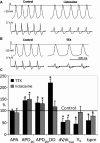Effects of 4-aminopyridine on action potentials generation in mouse sinoauricular node strips
- PMID: 26156968
- PMCID: PMC4552527
- DOI: 10.14814/phy2.12447
Effects of 4-aminopyridine on action potentials generation in mouse sinoauricular node strips
Abstract
The physiological role of Ito has yet to be clarified. The goal of this study is to investigate the possible contribution of the transient outward current (Ito) on the generation of transmembrane action potentials (APs) and the sensitivity of mouse sinoauricular node (SAN) cells to a 4-aminopyridine (4AP) as Ito blocker. The electrophysiological identification of cells was performed in the sinoauricular node artery area (nstrips = 38) of the subendocardial surface using microelectrode technique. In this study, for the first time, it was observed that dependence duration of action potential at the level of 20% repolarization (APD20) level under a 4AP concentration in the pacemaker SAN and auricular cells corresponds to a curve predicted by Hill's equation. APD20 raised by 70% and spike duration of AP increased by 15-25%, when 4AP concentration was increased from 0.1 to 5.0 mmol/L. Auricular cells were found to be more sensitive to 4AP than true pacemaker cells. This was accompanied by a decrease in the upstroke velocity as compared to the control. Our data and previous findings in the literature lead us to hypothesize that the 4AP-sensitive current participates in the repolarization formation of pacemaker and auricular type cells. Thus, study concerning the inhibitory effects of lidocaine and TTX on APD20 can explain the phenomenon of the decrease in upstroke velocity, which, for the first time, was observed after exposure to 4AP. Duration of AP at the level of 20% repolarization (APD20) under a 4-AP concentration 0.5 mmol/L in the true pacemaker cells lengthen by 60-70% with a control.
Keywords: 4‐aminopyridine; TTX; mouse; sinoauricular node; transmembrane action potential.
© 2015 The Authors. Physiological Reports published by Wiley Periodicals, Inc. on behalf of the American Physiological Society and The Physiological Society.
Figures




References
-
- Aréchiga-Figueroa IA, Rodríguez-Martínez M, Albarado A, Torres-Jácome J. Sánchez-Chapula JA. Multiple effects of 4-aminopyridine on feline and rabbit sinoatrial node myocytes and multicellular preparations. Pflugers Arch. 2010;459:C345–C355. - PubMed
-
- Boyett MR, Honjo H, Yamamoto M, Nikmaram MR, Niwa R. Kodama I. Regional differences in effects of 4-aminopyridine within the sinoatrial node. Am. J. Physiol. 1998;275:C1158–C1168. - PubMed
-
- Boyett MR, Honjo H, Lei M. Kodama I. Transient outward K+ current, ito, in the sinoatrial node. Cardiovasc. Res. 2001;52:C519–C520. - PubMed
-
- Golovko VA. Ion and temperature effect on generation of cardiac rhythm of vertebrates. Leningrad: Nauka; 1989. p. 152.
LinkOut - more resources
Full Text Sources
Other Literature Sources
Miscellaneous

